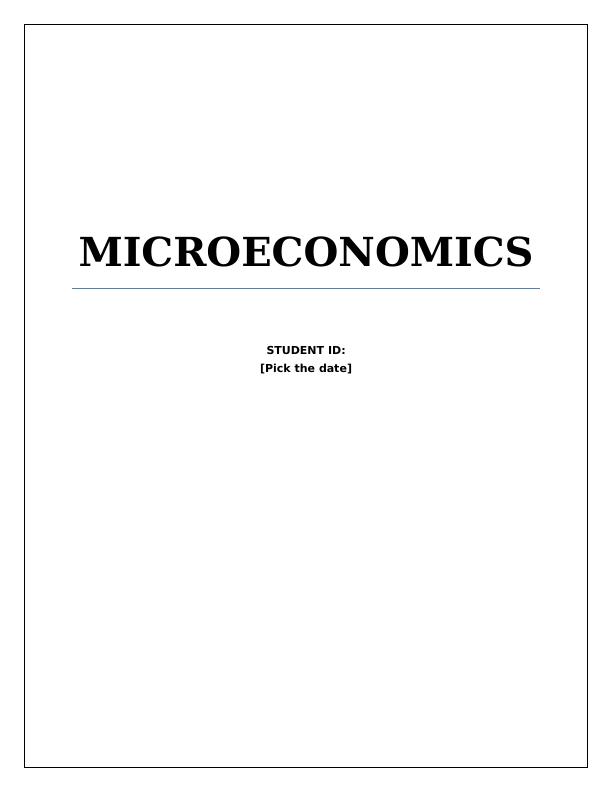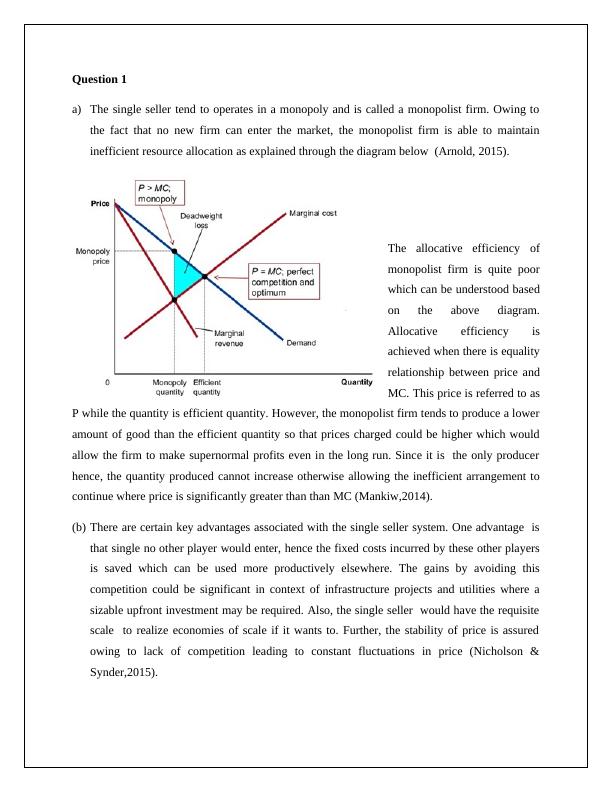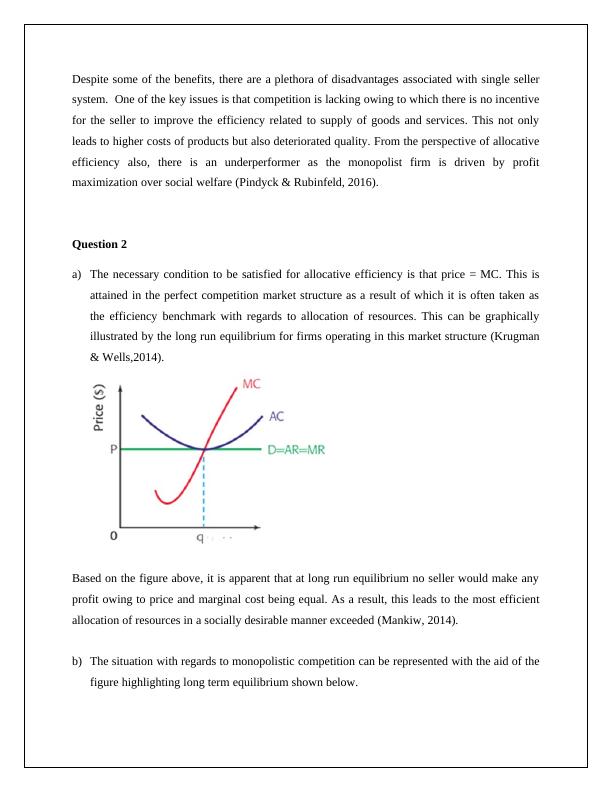Monopolist Firm and Allocative Efficiency
Added on 2022-12-28
9 Pages1593 Words97 Views
MICROECONOMICS
STUDENT ID:
[Pick the date]
STUDENT ID:
[Pick the date]

Question 1
a) The single seller tend to operates in a monopoly and is called a monopolist firm. Owing to
the fact that no new firm can enter the market, the monopolist firm is able to maintain
inefficient resource allocation as explained through the diagram below (Arnold, 2015).
The allocative efficiency of
monopolist firm is quite poor
which can be understood based
on the above diagram.
Allocative efficiency is
achieved when there is equality
relationship between price and
MC. This price is referred to as
P while the quantity is efficient quantity. However, the monopolist firm tends to produce a lower
amount of good than the efficient quantity so that prices charged could be higher which would
allow the firm to make supernormal profits even in the long run. Since it is the only producer
hence, the quantity produced cannot increase otherwise allowing the inefficient arrangement to
continue where price is significantly greater than than MC (Mankiw,2014).
(b) There are certain key advantages associated with the single seller system. One advantage is
that single no other player would enter, hence the fixed costs incurred by these other players
is saved which can be used more productively elsewhere. The gains by avoiding this
competition could be significant in context of infrastructure projects and utilities where a
sizable upfront investment may be required. Also, the single seller would have the requisite
scale to realize economies of scale if it wants to. Further, the stability of price is assured
owing to lack of competition leading to constant fluctuations in price (Nicholson &
Synder,2015).
a) The single seller tend to operates in a monopoly and is called a monopolist firm. Owing to
the fact that no new firm can enter the market, the monopolist firm is able to maintain
inefficient resource allocation as explained through the diagram below (Arnold, 2015).
The allocative efficiency of
monopolist firm is quite poor
which can be understood based
on the above diagram.
Allocative efficiency is
achieved when there is equality
relationship between price and
MC. This price is referred to as
P while the quantity is efficient quantity. However, the monopolist firm tends to produce a lower
amount of good than the efficient quantity so that prices charged could be higher which would
allow the firm to make supernormal profits even in the long run. Since it is the only producer
hence, the quantity produced cannot increase otherwise allowing the inefficient arrangement to
continue where price is significantly greater than than MC (Mankiw,2014).
(b) There are certain key advantages associated with the single seller system. One advantage is
that single no other player would enter, hence the fixed costs incurred by these other players
is saved which can be used more productively elsewhere. The gains by avoiding this
competition could be significant in context of infrastructure projects and utilities where a
sizable upfront investment may be required. Also, the single seller would have the requisite
scale to realize economies of scale if it wants to. Further, the stability of price is assured
owing to lack of competition leading to constant fluctuations in price (Nicholson &
Synder,2015).

Despite some of the benefits, there are a plethora of disadvantages associated with single seller
system. One of the key issues is that competition is lacking owing to which there is no incentive
for the seller to improve the efficiency related to supply of goods and services. This not only
leads to higher costs of products but also deteriorated quality. From the perspective of allocative
efficiency also, there is an underperformer as the monopolist firm is driven by profit
maximization over social welfare (Pindyck & Rubinfeld, 2016).
Question 2
a) The necessary condition to be satisfied for allocative efficiency is that price = MC. This is
attained in the perfect competition market structure as a result of which it is often taken as
the efficiency benchmark with regards to allocation of resources. This can be graphically
illustrated by the long run equilibrium for firms operating in this market structure (Krugman
& Wells,2014).
Based on the figure above, it is apparent that at long run equilibrium no seller would make any
profit owing to price and marginal cost being equal. As a result, this leads to the most efficient
allocation of resources in a socially desirable manner exceeded (Mankiw, 2014).
b) The situation with regards to monopolistic competition can be represented with the aid of the
figure highlighting long term equilibrium shown below.
system. One of the key issues is that competition is lacking owing to which there is no incentive
for the seller to improve the efficiency related to supply of goods and services. This not only
leads to higher costs of products but also deteriorated quality. From the perspective of allocative
efficiency also, there is an underperformer as the monopolist firm is driven by profit
maximization over social welfare (Pindyck & Rubinfeld, 2016).
Question 2
a) The necessary condition to be satisfied for allocative efficiency is that price = MC. This is
attained in the perfect competition market structure as a result of which it is often taken as
the efficiency benchmark with regards to allocation of resources. This can be graphically
illustrated by the long run equilibrium for firms operating in this market structure (Krugman
& Wells,2014).
Based on the figure above, it is apparent that at long run equilibrium no seller would make any
profit owing to price and marginal cost being equal. As a result, this leads to the most efficient
allocation of resources in a socially desirable manner exceeded (Mankiw, 2014).
b) The situation with regards to monopolistic competition can be represented with the aid of the
figure highlighting long term equilibrium shown below.

End of preview
Want to access all the pages? Upload your documents or become a member.
Related Documents
Monopoly Market Structure: Advantages and Disadvantageslg...
|8
|1375
|63
Monopoly Market Structure and Resource Allocationlg...
|7
|1104
|40
Monopoly & Monopolistic Competition in Australialg...
|10
|2512
|473
The Perfect Competition Marketlg...
|11
|2522
|389
(PDF) Business and Economics Researcheslg...
|11
|1981
|107
Maximizing Profits and Monopoly Marketlg...
|8
|1364
|93
